The Belle Époque
John McCabe
After many decades of military altercations in Europe, the Treaty
of Frankfurt on May 10th, 1871, finally brought some peace for
a few decades. The ensuing decades are today loosely referred
to as the "Belle Époque". It lasted right
up to the summer of 1914, when Germany declared war on France
and the horrors of WW I began.
The Worlds Fair of 1889 in Paris was exemplary
of the Belle Époque. Thirty million visitors got a glimpse
of what the future would likely bring. It was a grand event.
The fairgrounds were electrically lit up until midnight for the
first time. The setting must have seemed surreal to most visitors.
Amazed crowds would delight in viewing countless fascinating
displays of entertainment, science and technology. An engineer
by the name of Gustave Eiffel had managed to have 7 million holes
drilled into 15,000 steel plates. He then had them all screwed,
bolted and welded together. The resulting 7,000 ton steel tower,
famous today all over the world as the Eiffel Tower, seemed to
practically touch the sky above. Like a huge, ominous index finger
pointing 984 feet up into the air, it boldly prophesized the
future: "The sky's the limit!".
The Belle Époque was a fantastic
time period. Optimism, excitement, free thinking, ingenuity and
invention, and the promise of a better life with more prosperity
abounded. It was simply a celebration of mankind. All the best
bits and pieces of mankind's past trials and tribulations seemed
to have finally come together. The arts, literature, sciences,
and technology all blossomed beautifully. Even a guy by the name
of Charles Darwin, who,in 1859, dared to challenge the biblical
story of creation with a new evolutionary theory, became mandatory
reading for many - at a time, when Darwin had already long left
the public circuit and chosen a life of semi-reclusivity. One
new invention was chased by the next and industry was flourishing
unbridled in Europe and America. In 1816, the United States had
issued a mere 3,000 patents. By 1896, the height of the Belle
Époque, this figure had risen to 56,000.
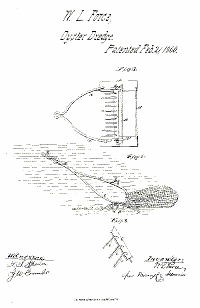 The spirit of invention was also alive and well
in the American oyster industry. Pictured we see a '"new
and improved" oyster dredge, patented by Wm. L. Force in
1860. The dredge had a sled design. A steel bar with strong teeth,
reminiscent of a massive garden rake, scooped up the oysters
and fed them into a steel link bag located behind it. While the
French were already forging towards the perfection of oyster
cultivation, the Americans were perfecting oyster exploitation.
By 1920, huge American oyster steamers with crews of 25 men were
dragging many of these dredges simultaneously. A typical oyster
steamer of this size could harvest 8,000 bushels of oysters per
day.
The spirit of invention was also alive and well
in the American oyster industry. Pictured we see a '"new
and improved" oyster dredge, patented by Wm. L. Force in
1860. The dredge had a sled design. A steel bar with strong teeth,
reminiscent of a massive garden rake, scooped up the oysters
and fed them into a steel link bag located behind it. While the
French were already forging towards the perfection of oyster
cultivation, the Americans were perfecting oyster exploitation.
By 1920, huge American oyster steamers with crews of 25 men were
dragging many of these dredges simultaneously. A typical oyster
steamer of this size could harvest 8,000 bushels of oysters per
day.
Although poverty was still wide spread,
a large and most affluent business class evolved alongside the
nobles, which rejoiced in spending lots money on "the 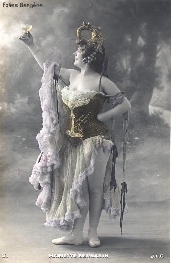 finer things
in life". Oysters were, of course, a big part of these "finer
things", as was Champagne. Champagne, the "King of
Wines", and the oyster, the "Queen of the Sea",
were celebrated as a match made in heaven. Many discreet little
establishments called "Séparées"
started popping up in and around Paris, which served oysters
and Champagne for breakfast, lunch and dinner. Champagne houses
were making money hand over fist during these decades. Oysters
were being consumed at record levels. Ornate three-pronged oyster
forks and finely crafted oyster plates and platters with beautiful
hand-painted motifs became fashionable components of tableware
sets. Sterling silver oyster forks and French porcelain oyster
platters of the Belle Époque and the first half of the
20th century, are highly prized collectibles today.
finer things
in life". Oysters were, of course, a big part of these "finer
things", as was Champagne. Champagne, the "King of
Wines", and the oyster, the "Queen of the Sea",
were celebrated as a match made in heaven. Many discreet little
establishments called "Séparées"
started popping up in and around Paris, which served oysters
and Champagne for breakfast, lunch and dinner. Champagne houses
were making money hand over fist during these decades. Oysters
were being consumed at record levels. Ornate three-pronged oyster
forks and finely crafted oyster plates and platters with beautiful
hand-painted motifs became fashionable components of tableware
sets. Sterling silver oyster forks and French porcelain oyster
platters of the Belle Époque and the first half of the
20th century, are highly prized collectibles today.
This French post card series from the Belle
Époque is most interesting and amusing (post cards can
be clicked for enlargement):
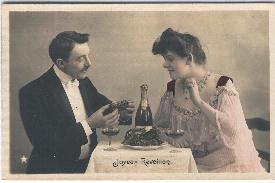
The post card series is titled Joyeux Réveillon
("Joyous Midnight Repast"). A dashing young man presents
a charming young lady with an oyster. But what kind?
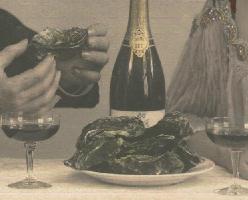
Voila. These are Portuguese oysters (Pacific
oysters did not exist in France when these post cards were made).
The dashing young man chose Portuguese oysters instead of the
far more expensive European oysters for the lady of his dreams.
Hence, he was possibly a bit of a cheap skate. He did, however,
not skimp on the bubbly. It's real Champagne - a quite sweet
Demi-Sec to be sure. Today, the dosage of a Demi-Sec (today)
can contain a maximum of 50 grams per liter of residual sugar.
Unlike England and the United States, where drier Champagnes
(Extra-Dry, Brut, Extra-Brut) were (and are) preferred, the French,
around the turn of the century, often had a bit of a sweet tooth
when it came to Champagne. The classic "coupe design"
was often the glass of choice for Champagne during those days
(has since been replaced by flutes and tulip style glasses).
Today, dry Champagnes (and many other dry white wines) are preferred
with oysters.
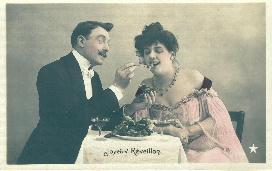
He now attempts to feed the tasty mollusk
to his sweetheart - with an oyster fork. The use of an oyster
fork was considered "most civilized" during the Belle
Époque. Today, oyster forks are only rarely used with
raw oysters. Slurping the living animal off its half shell is
now considered "most civilized' as well.

Things are obviously going quite well between
these two. Only one oyster was consumed. Oddly, the rest of the
oysters remain unopened on the plate. The king of wines seems
to have taken full charge of this joyous moment.
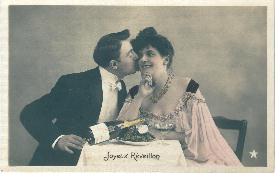
In this final post card (at least in my
possession. There may be more...), Prince Charming moves in on
his dream girl. That lone oyster sloshing in Champagne in her
tummy seems to have made her most receptive to his advances.


